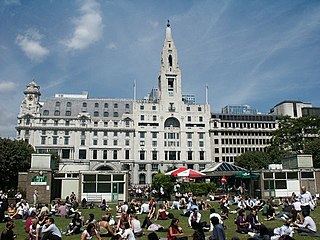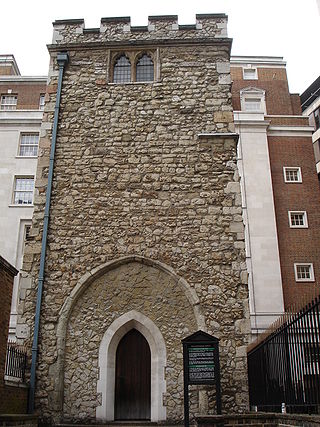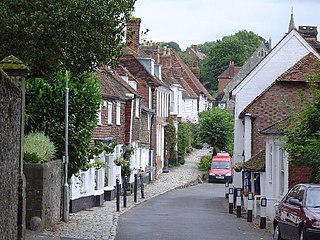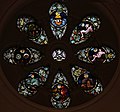
Sherborne Abbey, otherwise the Abbey Church of St. Mary the Virgin, is a Church of England church in Sherborne in the English county of Dorset. It has been a Saxon cathedral (705–1075), a Benedictine abbey church (998–1539), and since 1539, a parish church.

Clerkenwell is an area of central London, England.

Finsbury is a district of Central London, forming the southeastern part of the London Borough of Islington. It borders the City of London.

Thame is a market town and civil parish in Oxfordshire, about 13 miles (21 km) east of the city of Oxford and 10 miles (16 km) southwest of Aylesbury. It derives its name from the River Thame which flows along the north side of the town and forms part of the county border with Buckinghamshire. The parish includes the hamlet of Moreton south of the town. The 2011 Census recorded the parish's population as 11,561. Thame was founded in the Anglo-Saxon era and was in the kingdom of Wessex.

Froxfield is a village and civil parish in the English county of Wiltshire. The parish is on the Wiltshire-West Berkshire border, and the village lies on the A4 national route about 2.5 miles (4 km) west of Hungerford and 7 miles (11 km) east of Marlborough.

All Hallows Staining was a Church of England church located at the junction of Mark Lane and Dunster Court in the north-eastern corner of Langbourn ward in the City of London, England, close to Fenchurch Street railway station. All that remains of the church is the tower, built around AD 1320 as part of the second church on the site. Use of the grounds around the church is the subject of the Allhallows Staining Church Act 2010.

Sutton Valence is a village about five miles (8 km) SE of Maidstone, Kent, England on the A274 road going south to Headcorn and Tenterden. It is on the Greensand Ridge overlooking the Vale of Kent and Weald. St Mary's Church is on the west side of the village on Chart Road, close to the junction of the High Street with the A274. Another landmark is Sutton Valence Castle on the east side of the village, of which only the ruins of the 12th-century keep remain, under the ownership of English Heritage.

St Luke's is an area in London, England and is located in the London Borough of Islington. It lies just north of the border with the City of London near the Barbican Estate, and the Clerkenwell and Shoreditch areas.
Stoke Newington was an ancient parish in the county of Middlesex. It was both a civil parish, used for administrative purposes, and an ecclesiastical parish of the Church of England.

St Mary Magdalene Church is one of Hope Church Islington's places of worship, an Anglican church on Holloway Road in north London dedicated to Jesus' companion Mary Magdalene. It is located in St Mary Magdalene Gardens opposite Islington Central Library. St Mary Magdalene is part of the Parish of Hope Church Islington. In 2013 its sister church St David's on Westbourne road was reopened so St Mary Magdalene now functions as one of two worship sites of the Parish, with a single leadership and a staff team. The early 19th century building accommodates the activities of the church congregation, including church services, a winter night shelter, 'Mini Mags' – a toddlers group, and provides spaces to other users. Baptisms and confirmations, marriages and funerals are regularly held here. The building and its iron railings are both Grade II* listed structures, having first been listed in 1954.

Hilmarton is a village and civil parish in North Wiltshire, in the west of England. The village lies on the A3102 between the towns of Calne and Wootton Bassett, and 2 miles (3.2 km) south of Lyneham. The parish includes the village of Goatacre and the hamlets of Catcomb, Clevancy, Highway and New Zealand.

Union Chapel is a working Congregational church, live-entertainment venue and charity drop-in centre for the homeless in Islington, London, England. Built in the late 19th century in the Gothic revival style, the church is a Grade I-listed building. It is at the north end of Upper Street, near Highbury Fields.

St James' Church is an 18th-century chapel situated in the grounds of Packington Hall, near Meriden, Warwickshire. It is a Grade I listed building.

The Church of the Holy and Undivided Trinity with Saint Jude, Upper Chelsea, commonly called Holy Trinity Sloane Street or Holy Trinity Sloane Square, is a Church of England parish church in London, England. It was built in 1888–90 at the south-eastern side of Sloane Street, to a striking Arts and Crafts design, by the architect John Dando Sedding, and paid for by 5th Earl Cadogan, in whose London estate it lay. It replaced an earlier building only half its size which, at the time of its demolition, was less than 60 years old.

Saint Chrysostom's Church is the parish church in Victoria Park, Manchester, England. The church is of the Anglo-Catholic tradition, and also has a strong tradition of being inclusive and welcoming.

The Parish Church of St Peter, Great Berkhamsted, is a Church of England, Grade II* listed church in the town of Berkhamsted, Hertfordshire, in the United Kingdom. It stands on the main High Street of the town and is recognisable by its 85-foot (26 m) clock tower.

The Church of St Mary of the Assumption is in Yorkshire Street, Burnley, Lancashire, England. It is an active Roman Catholic parish church in the diocese of Salford. The church is recorded in the National Heritage List for England as a designated Grade II listed building. It was built between 1846 and 1849 to replace a smaller chapel on a different site. The church was designed by Weightman and Hadfield in Decorated style, and a chapel was added to it in 1879.

St James the Less and St Helen Church is a Roman Catholic Parish church in Colchester, Essex, England. It was built in 1837 and designed by Joseph John Scoles. It is situated on Priory Street between the junction with East Hill and St Thomas More Catholic Primary School in the city centre. Next to it is the church hall which was built in 1911 and designed by Alexander Scoles.

William Lambe (1495–1580) was a wealthy cloth merchant in the City of London during Tudor times who engaged in a wide range of philanthropic deeds, most notably endowing the construction of St James' Church, Islington, the construction of the eponymous Lamb's Conduit, traces of which remain in a number of London street names, and the endowment of Sutton Valence School. He was a devout protestant and was friends with a number of notable protestant clerics of the time.

































